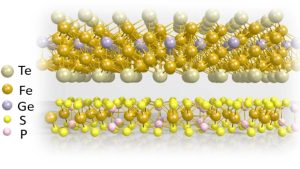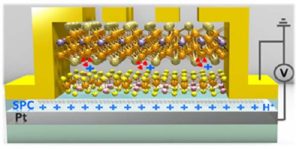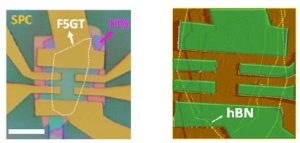 Electric gate-controlled exchange-bias effect in van der Waals heterostructures has been has observed for the first time, according to RMIT University in Australia, which describes the effect as “a promising platform for future energy-efficient, beyond-CMOS electronics”.
Electric gate-controlled exchange-bias effect in van der Waals heterostructures has been has observed for the first time, according to RMIT University in Australia, which describes the effect as “a promising platform for future energy-efficient, beyond-CMOS electronics”.
“To date, very limited electrically tunable exchange-bias effects have been experimentally demonstrated in some oxide multi-ferroic thin film systems”, according to the university, but not in van der Waals heterostructures.
The effect originates from antiferomagnetic-ferromagnetic interface coupling induced unidirectional anisotropy in the heterostructure, it went on to say, and it is seen as a step-wise shift the BH-loop of the magnetic material to the left or right under the control of a gate electrode.
In the research, which is all at deep cryogenic temperatures, the blocking temperature of the exchange-bias effect was tuned using an electric gate, which would allow the exchange-bias field to be turned on and off in future spintronic transistors, according to RMIT.
 The device in which the effect was demonstrated has been dubbed a solid-proton field-effect transistor (left), which is a triple-layer of ferromagnetic (Fe5GeTe2) – antiferromagnetic (FePS3) – solid proton conductor. The top and middle materials are two dimensional, and form a heterostructure (above), held together by the same van der Waals forces that hold graphene layers together. The top contact is gold and the bottom gate contact is platinum.
The device in which the effect was demonstrated has been dubbed a solid-proton field-effect transistor (left), which is a triple-layer of ferromagnetic (Fe5GeTe2) – antiferromagnetic (FePS3) – solid proton conductor. The top and middle materials are two dimensional, and form a heterostructure (above), held together by the same van der Waals forces that hold graphene layers together. The top contact is gold and the bottom gate contact is platinum.
 The device under optical (left) and atomic force (right) microscopy
The device under optical (left) and atomic force (right) microscopy
“The blocking temperature of the exchange-bias effect can be effectively tuned via electric gate,” said researcher Guolin Zheng, “and more interestingly, the exchange-bias field can be switched on and off repeatably under various gate voltages.”
“The gate-dependent exchange-bias effects can be well-explained based on our calculations,” said fellow researcher Lan Wang. “Under different proton intercalations, the affected antiferomagnetic-ferromagnetic coupling-induced unidirectional anisotropy energy and the transformation of FePS3 between an uncompensated antiferomagnetic and a compensated antiferomagnetic lead to the various interesting phenomena. Again, this study is a significant step towards vdW heterostructure-based magnetic logic for future low-energy electronics.”
RMIT worked with South China University of Technology and other institutions on this project, under the auspices of FLEET, the Australian Research Council Centre of Excellence in Future Low-Energy Electronics Technologies – which brings together Australian and international experts to develop technology for ultra-low energy electronics.
The work is described in ‘Electric control of exchange bias effect in FePS3−Fe5GeTe2 van der Waals heterostructures’, published in Nano Letters – payment required for full access.
Fleet was behind two other recent 2d material discoveries: Dissimilar 2D materials turn photons into electrons and Optically-active 2D heterostructures.
